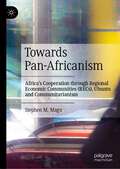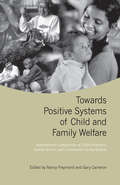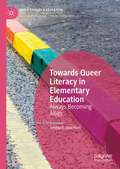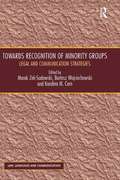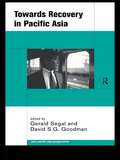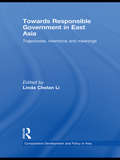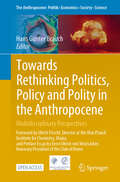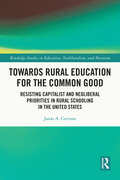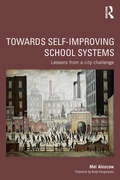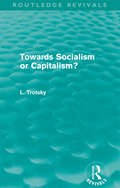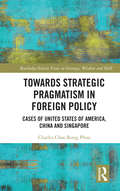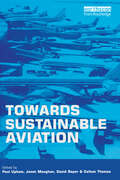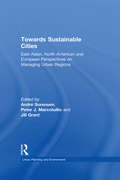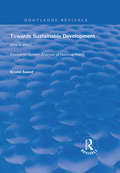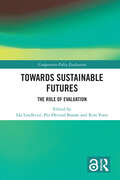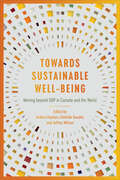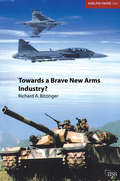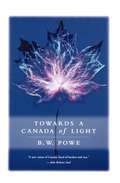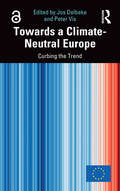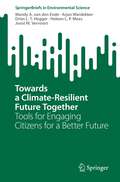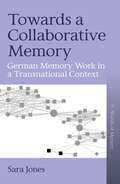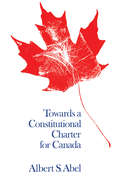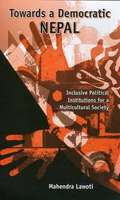- Table View
- List View
Towards Pan-Africanism: Africa’s Cooperation through Regional Economic Communities (RECs), Ubuntu and Communitarianism
by Stephen M. MaguThis book traces the development and impact of regional economic communities (RECs) in Africa and addresses a timely question: do REC members, and the REC itself, positively influence member states’ behaviors towards other members and more broadly, regionally and continentally due to REC membership? ‘Changing member states’ behaviors’ is measured across three ‘interconnected, fundamental dimensions of societal-systems’ proposed by Marshall and Elzinga Marshall in CSP’s Global Repot 2017. These are i) the persistence of conflict or its counterpoint, achieving peace, ii) fostering democratization and better governance, and iii) achieving socio-economic development and (as proposed by this research, a fourth dimension), iv) being active participants in multilateralism? Is membership in a REC ultimately beneficial to the member and other countries in the region? While there are no clear and obvious – at least, discernible traditional – benefits such as increase in trade (perhaps because Africa’s overall trade relative to the world is about 3 percent), there are other non trade benefits (e.g., decrease in conflict, coercion to take certain actions towards peace and refrain from others, coups and wars) presenting in REC member states. These in/actions, abilities, coercions, exclusions and cooperation instances are outlined and discussed in the book.
Towards Positive Systems of Child and Family Welfare: International Comparisons of Child Protection, Family Service, and Community Caring Systems
by Gary Cameron Nancy FreymondThe need for services that respond to the ‘maltreatment’ of children and to the struggles of families is at the core of social service systems in all developed nations. While these child and family welfare systems confront similar problems and incorporate common elements, there are substantial differences in philosophy, organization, and operation across international settings and models.In this new collection of essays, Nancy Freymond and Gary Cameron have brought together some of the finest international minds to provide an original and integrated discussion of child protection, family service, and community caring models of child and family welfare. The volume not only examines child protection and family service approaches within Western nations – including Canada, the United States, England, the Netherlands, France, and Sweden – it is also the first comparative study to give equal attention to Aboriginal community caring models in Canada and New Zealand.The comparisons made by the essays in this volume allow for a consideration of constructive and feasible innovations in child and family welfare and contribute to an enriched debate around each system. This book will be of great benefit to the field for many years to come.
Towards Queer Literacy in Elementary Education: Always Becoming Allies (Queer Studies and Education)
by Selena E. Van HornThis book blends multiple research studies, historical and current events, reflective teaching examples, and guidance for LGBTQ+ inclusion and queer pedagogy in elementary schools. It is divided into three sections to guide the readers from a broad understanding of the hxstories of LGBTQ+ discriminations, rights, and some communities’ resistance to LGBTQ+ children, teachers, and curriculum to a focused invitation into the author's own reflections, teaching, and discussions with children about LGBTQ+ literature and topics. The volume provides hxstories, theoretical and methodological inquiry, resources, and encouragement for teacher-researchers ready to engage LGBTQ+-inclusion and queer literacy pedagogy in their classrooms, schools, and communities.
Towards Recognition of Minority Groups: Legal and Communication Strategies (Law, Language and Communication)
by Marek Zirk-Sadowski Bartosz WojciechowskiThis volume analyses current debates concerning problems in the nature, justification, and legal protection of human rights for minorities, with reference to the issues surrounding social milieu as a source of any legitimized law, which is in itself in need of legal recognition as well as being an object of legal protection. With contributions from a global network of scientists across several continents, the work examines the debate dedicated to the understanding of the normative framework, expressed in terms of human rights that guarantee autonomous action in public and private for minority groups as well as individuals. The chapters go on to study the particular claims that need to be audible and visible for others in the public sphere with reference to the legal protection of human rights. The work concludes with the completion of an interpretative circle debating the issues of legal consensus and legal identity with respect to the specificity of the patterns and modes guiding human interactions. Going beyond the legal analysis to discuss communication strategies in human rights, this collection will be of great interest to those studying the philosophy and theory of law, practical philosophy in general, political sciences and theory of democracy.
Towards Recovery in Pacific Asia (Esrc Pacific Asia Programme Ser.)
by David S. G. Goodman Gerald SegalAttempts to define the Asian Crisis and its future course continue to be hotly contested. Towards Recovery in Pacific Asia deals with financial and industrial reform, defence policies, the 'Asian-Values' debate, corruption and croneyism; as well as China, Japan and intra-regional affairs. Rather than trying to resolve the heated debate about the causes of the crisis, this book reflects on underlying trends to examine the possible paths of recovery. Bringing together experts in the field, Towards Recovery in Pacific Asia suggests that recovery is by no means impossible nor as difficult as might at first have seemed. But it requires political reform, tackling specific economic problems and the international support of the US, European Union and World Bank. There are still causes for concern, such as Indonesia's transition from the Suharto era and political reform in China and, most significantly, Japan. With its highly topical focus on the social, political and economic development of the Asia Pacific region, this book represents a vital, up-to-date analysis for students and researchers in Asian studies, International Relations, International Political Economy, as well as policy makers and professionals working in, or with, Pacific Asia.
Towards Resilient Organizations and Societies: A Cross-Sectoral and Multi-Disciplinary Perspective (Public Sector Organizations)
by Rómulo Pinheiro Maria Laura Frigotto Mitchell YoungThis open access book brings together scholars in the fields of management, public policy, regional studies, and organization theory around the concept of resilience. The aim is to provide a more holistic understanding of the complex phenomenon of resilience from a multi-sectorial, cross-national, and multidisciplinary perspective. The book facilitates a conversation across diverse disciplinary specializations and empirical domains. The authors contribute both to theory testing and theory development and provide key empirical insights useful for societies, organizations, and individuals experiencing disruptive pressures, not least in the context of a post-COVID-19 world. Diverse chapters are held together by a clear organization of the volume across levels of analysis (resilience in organizations and societies) and by an original perspective on resilience derived from an extended review, by the editors, of the existing literature and knowledge gaps, according to which each of the individual chapter contributions is positioned and connected to.
Towards Responsible Government in East Asia: Trajectories, Intentions and Meanings (Comparative Development and Policy in Asia)
by Linda Chelan LiThis book explores the idea of responsible government in East Asia, arguing that many recent governance crises have resulted from responsibility failures on a huge scale. It distinguishes between accountability, which it argues has been overemphasised recently, and responsibility, which it argues goes beyond accountability, true responsible government involving the actor in feeling liable for and taking responsibility for his or her actions. It shows how historically the concept of responsibility is more embedded in political discussions in Asia, whereas the concepts of democracy and accountability are more embedded in the intellectual traditions of Europe, but that the challenges of revolution and post-revolution, decolonization and post-colonization and neo-liberal globalization have complicated matters. Drawing on a wide range of case studies from East Asia, and relating the concepts discussed to political theory, ethics and social psychology, the book shows how actors in government and society interact to deliberate, produce or distract from the practice and perception of “responsible government”, and suggests how the concept of “responsible government”, better defined, might be encouraged to produce better governance.
Towards Rethinking Politics, Policy and Polity in the Anthropocene: Multidisciplinary Perspectives (The Anthropocene: Politik—Economics—Society—Science #35)
by Hans Günter BrauchHumankind faces two anthropogenic threats to its survival that are closely linked. The first is the end of the Holocene and the start of the Anthropocene, which was marked by the test of a nuclear bomb on 16 July 1945. In the prevailing peace and security narrative, nuclear weapons and the ‘other’ (country, bloc or alliance) pose a perceived threat to humankind’s survival. In the Anthropocene narrative, ‘we are the threat’ through our way of life and the burning of fossil fuels. The start of the Anthropocene coincides with a change in the international order with the setting up of the UN and the Bretton Woods Institutions. Three stages of this order are distinguished: the Cold War (bipolarity), the post-Cold War era (unipolarity), and the end of the rule-based global liberal order (multipolarity) on 24 February 2022. In this book ten multidisciplinary perspectives discuss complexity, Anthropocene geopolitics, peace and security discourses and the debate on the Anthropocene, planetary boundaries, complex crises and integrative geography in the Anthropocene, governance and politics, and the Patriacene and gender. Both existential threats for humankind are illustrated by cover photos of the first nuclear weapons test on 16 July 1945 and by Category 5 Hurricane Otis, an extreme weather event impacting on Acapulco in Mexico on 25 October 2023. The Anthropocene as a new epoch of Earth history coincides in 1945 with a change in the international order. In the security and peace narrative, the ‘other’ and nuclear weapons pose an existential threat; in the Anthropocene narrative. This dual existential change requires a rethinking of politics, policy and polity. In the social sciences, the Anthropocene is being discussed from multidisciplinary perspectives (geography, political science, and peace, security, and gender studies). This is an open access publication.
Towards Rural Education for the Common Good: Resisting Capitalist and Neoliberal Priorities in Rural Schooling in the United States (Routledge Studies in Education, Neoliberalism, and Marxism)
by Jason A. CervoneThis book examines the current and future state of rural education in North America through the lens of Franco Berardi’s Futurability. Through critical examination of examples and current trends toward corporatization and privatization of rural education, the volume highlights how future possibilities and social imagination in rural spaces have been limited by neoliberal forces, capitalist interests, and workforce education. Cervone demonstrates how Berardi’s concept of creating future can be embraced to foster critical thought, challenge injustices, and open opportunity. With this line of analysis, the book ultimately supports an ethos of a return to education for the common good. Bringing an important perspective to the field of rural education scholarship, this work will be of interest to scholars and researchers in sociology of education and education policy.
Towards Self-improving School Systems: Lessons from a city challenge
by Mel AinscowThis important new book draws lessons from a large-scale initiative to bring about the improvement of an urban education system. Written from an insider perspective by an internationally recognized researcher, it presents a new way of thinking about system change. This builds on the idea that there are untapped resources within schools and the communities they serve that can be mobilized in order to transform schools from places that do well for some children so that they can do well for many more. Towards Self-improving School Systems presents a strategic framework that can help to foster new, more fruitful working relationships: between national and local government; within and between schools; and between schools and their local communities. What is distinctive in the approach is that this is mainly led from within schools, with senior staff having a central role as system leaders. The book will be relevant to a wide range of readers throughout the world who are concerned with the strengthening of their national educational systems, including teachers, school leaders, policy makers and researchers. The argument it presents is particularly important for the growing number of countries where increased emphasis on school autonomy, competition and choice is leading to fragmentation within education provision. Foreword by Andy Hargreaves, Thomas More Brennan Chair in Education, Boston College, USA
Towards Socialism or Capitalism? (Routledge Revivals)
by Leon TrotskyFirst Published in 1926, Towards Socialism or Capitalism? considers how the socialised economy of Soviet Russia, isolated in a capitalist world after Lenin’s death, faced acute dangers. Trotsky and the Left Opposition alone fought the Stalinist degeneration of the state and party apparatus which threatened to open the door to capitalist restoration. The three articles in this book, written between 1925 and 1932, discuss the fundamental problems of the Soviet economy from the New Economic Policy to forced collectivization. Published here in one volume, they are indispensable steps in the development of Trotsky’s analysis of the Soviet Union, laid down in 1936 in ‘The Revolution Betrayed’.
Towards Strategic Pragmatism in Foreign Policy: Cases of United States of America, China and Singapore (Routledge-Solaris Focus on Strategy, Wisdom and Skill)
by Charles Chao PhuaWhat is pragmatism? Is it a means to an end, or an end in itself? Is it antithetical to ideology or morality? Arguing that pragmatism is a skill much more than an attribute, Phua examines how viewing it in this way can help achieve better foreign policy outcomes. He examines and contrasts the ways in which the United States, China and Singapore have incorporated pragmatism into their approaches to foreign policy. In doing so he debunks dualistic myths around pragmatism and ideology and promotes the view of pragmatism as a skill that can be developed. An essential primer for students, analysts and policymakers, with a fresh and practical approach to pragmatism.
Towards Sustainable Aviation
by Paul Upham Janet Maughan David Raper Callum ThomasAviation is integral to the global economy but it is also one of the main obstacles to environmentally sustainable development. It is one of the world's fastest growing - and most polluting - industries. What can be done to retain the economic and other benefits it brings, without the associated pollution, noise, congestion and loss of countryside? In this volume, industry, policy and research experts examine how to address the problems, and what it would take to achieve genuinely sustainable aviation - looking at technological, policy and demand-management options. Without far-reaching changes the problems caused by aviation can only multiply and worsen. This work seeks to take an important step in diagnosing the problems and in pointing towards their solutions.
Towards Sustainable Cities: East Asian, North American and European Perspectives on Managing Urban Regions (Urban Planning and Environment)
by Peter J. MarcotullioWhile there has been much recent research into achieving sustainability in urban areas, most of this is specific to a particular region. This volume broadens these discussions by extending the analysis from North American and European cities to include East Asian cities. Many cities in Asia have deep historical roots, have sustained dense populations through time and have grown prosperous in recent decades. They also face significant environmental degradation and other planning challenges. In bringing together and comparing strategies and experiences from three distinct global regions, this book offers unique insights and new perspectives on the challenges of moving towards greater urban sustainability. While questioning which strategies can promote sustainable cities in a global context, the book also illustrates that while formulae generated out of American and European experience cannot be universally applied, some of the analytical approaches and experience of the other developed countries can offer insights for those working in different contexts. It argues that managing urban change for greater urban sustainability in diverse regions requires detailed understanding of local issues and regional strategies as well as strong support from local communities.
Towards Sustainable Development: Essays on System Analysis of National Policy (Routledge Revivals)
by Khalid SaeedFirst published in 1998, this second edition includes the 10 published essays and 3 working papers collected in the first edition, as well as additional writings on sustainable development penned by Saeed and his students over the subsequent six years. Two of the original working papers were revised and published between editions and their published versions now appear. Lastly, the conclusion has been reformulated and the introduction contains insights from extended research. Part I comprises the first 7 chapters and deals with modelling generic issues concerning sustainable development. Part II comprises chapters 8 to 10 and extends the concepts from part I to the controversies on poverty and hunger, technological development, and entrepreneurship. Part III relates six case studies covering a variety of local issues in selected developing countries, including agricultural development policy in Pakistan, the impact of the rural credit system on Thailand’s agricultural economy, the problem of food self-sufficiency in Vietnam and water resources management in Saudi Arabia.
Towards Sustainable Futures: The Role of Evaluation (Comparative Policy Evaluation)
by Kim Forss Ida Lindkvist Per Øyvind BastøeTowards Sustainable Futures serves as a guide to better understand what roles evaluation can play in sustainability. Rather than proposing a single definition of sustainability or methodological approach, this book gives us the tools to improve the quality and relevance of evaluation of sustainability. Divided into two parts, the first part introduces the reader to key debates and challenges related to evaluation of sustainability. Part Two provides examples of methods and applications. By combining a stellar line up of specialists, theorists, and practitioners in the field of development evaluation with expert, accessible and engaged analysis of key issues, Towards Sustainable Futures is a must-read source for re-tooling and re-focussing evaluation towards the green transition imperative. It should be essential reading for scholars and practitioners of evaluation.Chapters 1, 4, 6 and 15 of this book are freely available as a downloadable Open Access PDF at http://www.taylorfrancis.com under a Creative Commons [Attribution-Non Commercial-No Derivatives (CC-BY-NC-ND)] 4.0 license.
Towards Sustainable Well-Being: Moving beyond GDP in Canada and the World
by Anders Hayden Jeffrey Wilson Céofride GaudetTowards Sustainable Well-Being examines existing efforts and emerging possibilities to improve upon gross domestic product as the dominant indicator of economic and social performance. Contributions from leading international and Canadian researchers in the field of beyond-GDP measurement offer a rich range of perspectives on alternative ways to measure well-being and sustainability, along with lessons from around the world on how to bring those metrics into the policy process. Key topics include the policy and political impacts of major beyond-GDP measurement initiatives; the most promising possibilities and policy applications for beyond-GDP measurement; key barriers to introducing beyond-GDP metrics; and complementary measures to ensure new measurements are not merely calculated but taken into account in policymaking. The book highlights a distinction between a reformist beyond-GDP vision, which seeks to improve policymaking and quality of life within existing political and economic institutions, and a transformative vision aiming for more fundamental change including a move beyond economic growth. Illustrating the many advances that have occurred in Canada and internationally, Towards Sustainable Well-Being proposes next steps for both the reformist and transformative visions, as well as possible common ground between them in the pursuit of sustainable well-being.
Towards a Brave New Arms Industry? (Adelphi series)
by Richard BitzingerIn the post-Cold War era, most countries have been forced to radically reduce their arms industries, and abandoned self-sufficiency in favour of a subordinate role in an increasingly globalized worldwide defence industry. This has significant implications for the future of armaments production, for proliferation, and for arms control.
Towards a Canada of Light
by Bruce W. PoweB.W. Powe’s visionary work of political philosophy dares to re-imagine Canada. First conceived in 1993, this fully revised, expanded, updated edition, complete with an inspired new introduction that considers Canada in a post-9/11 context, is a landmark book that has become a classic text for understanding the work-in-progress that is Canada. Countering George Grant’s pessimistic Lament for a Nation, which defined the intellectual climate in Canada for decades, Powe argues that our country is in fact a completely original model of what an enlightened polity might be for the 21st century. Here is a passionately inspired portrait of Canada as a communication state – a counter-nation of loose ties and subtle associations where dialogue, ideas, debate and the exchange of information is the currency that holds us lightly together. Towards a Canada of Light points to the urgent realization of a new and liberating way of what it means to be Canadian.
Towards a Climate-Neutral Europe: Curbing the Trend
by Jos Delbeke Peter VisThis book explains the EU’s climate policies in an accessible way, to demonstrate the step-by-step approach that has been used to develop these policies, and the ways in which they have been tested and further improved in the light of experience. The latest changes to the legislation are fully explained throughout. The chapters throughout this volume show that no single policy instrument can bring down greenhouse gas emissions. The challenge facing the EU, as for many countries that have made pledges under the Paris Agreement, is to put together a toolbox of policy instruments that is coherent, delivers emissions reductions, and is cost-effective. The book stands out by the fact it covers the EU’s emissions trading system, the energy sector and other economic sectors, including their development in the context of international climate policy. This accessible book will be of great relevance to students, scholars and policy makers alike.
Towards a Climate-Resilient Future Together: Tools for Engaging Citizens for a Better Future (SpringerBriefs in Environmental Science)
by Mandy A. van den Ende Arjan Wardekker Dries L.T. Hegger Heleen L.P. Mees Joost M. VervoortAlthough many local authorities underline the important role of citizens in climate adaptation, many experience difficulties with organizing citizen participation in a way that is meaningful to both citizens and policymakers. Climate change is for many simply not a top priority. Besides, the future is often rather abstract to people, citizens in particular. We argue that practical tools are needed to help citizens structure the process of thinking about and designing the future of their living environment under the impacts of climate change. The toolbox Towards a climate-resilient future together offers practical foresight methods and tools for organizing citizen participation in the process of building climate-resilient futures. It provides an overview of the state the art of and hands-on guidance for executing participatory foresight methods and showcases some of the lessons learned from several international research programs on citizen engagement. In doing so, the toolbox can assist practitioners, students and academics concerned with the question of how local communities in urban and rural areas could adapt to climate change impacts and become more resilient in the future. It is suitable for readers without any experience in citizen participation and/or foresight, while more experienced readers will find innovative combinations of methods and tools that are unique within the field of citizen participation and foresight..
Towards a Collaborative Memory: German Memory Work in a Transnational Context (Worlds of Memory #9)
by Sara JonesFocusing on the memory of the German Democratic Republic, Towards a Collaborative Memory explores the cross-border collaborations of three German institutions. Using an innovative theoretical and methodological framework, drawing on relational sociology, network analysis and narrative, the study highlights the epistemic coloniality that has underpinned global partnerships across European actors and institutions. Sara Jones reconceptualizes transnational memory towards an approach that is collaborative not only in its practices, but also in its ethics, and shows how these institutions position themselves within dominant relationship cultures reflected between East and West, and North and South.
Towards a Constitutional Charter for Canada
by Albert S. AbelIn this timely book, edited from a manuscript left unfinished at his death, one of Canada's leading constitutional scholars presents his prescription for constitutional change. The book diagnoses the failure of Canada's present constitution, both in dealing with the country's distinctive characteristics--regional identity and regional disparity--and in providing for effective national economic management. Drawing upon comparisons with other federal constitutions and with the European Economic Community, it proposes a new constitutional charter which would shift important responsibilities to the provinces while strengthening the economic powers of the central government. Specific recommendations are set out for a provincial residuary power, restructured taxing and spending powers, and a Canadian Equalization Council--the last a unique redistributive mechanism designed to ensure that residents of every province have access to adequate government services. Throughout, the plan pays close attention to the need to formulate constitutional provisions in a way which protects them against distortion by subsequent interpretation. At a time when the need for solutions to Canada's constitutional problems has never been more pressing, Albert Abel's is a particularly valuable individual contribution to the Canadian constitutional debate.
Towards a Democratic Nepal
by Mahendra LawotiThis book analyses the problem of the increasing political exclusion of ethnic, caste and gender groups in democratic Nepal and discusses its consequences for democracy and the stability of the country. While outlining alternative democratic institutions and proposing specific institutions that can include the diverse socio-cultural groups in Nepal, this book: - analyses the Maoist insurgency, arguing that political exclusion was a major cause for its genesis and growth; - examines the causes for the lack of democratic consolidation in Nepal; - provides the first comprehensive critique of the 1990 Constitution, identifying it as an important factor leading to the political exclusion of ethnic groups; - suggests the setting up of a new Constituent Assembly to address the social and political crisis in Nepal; - makes important recommendations to shape an inclusive and democratic Nepal which include federalism; a powerful House of Nationalities; a proportional electoral system; affirmative action policies and reservations; declaration of a secular state; a centralized judicial review; and the protection of minority rights in the Constitution. Overall, the author argues that unless Nepal's ruling elite becoms senstive to the needs of marginalized and excluded groups, the country could witness an escalation in violence. Highlighting a wide range of issues crucial to strengthening democracy in Nepal, this book is of interest ot students and academics studing Nepal and South Asia.
Towards a Francophone Community
by Robin S. GendronUsing extensive archival research, Gendron rebuts the argument of Quebec nationalists and scholars that the Canadian government's neglect of French Africa forced Quebec to develop its own international identity. Towards a Francophone Community shows that there had been active federal interest in French African affairs since the late 1940s, within the context of developments in NATO and the Cold War, the vagaries of Canada's relations with France, and the Quiet Revolution in Quebec.
